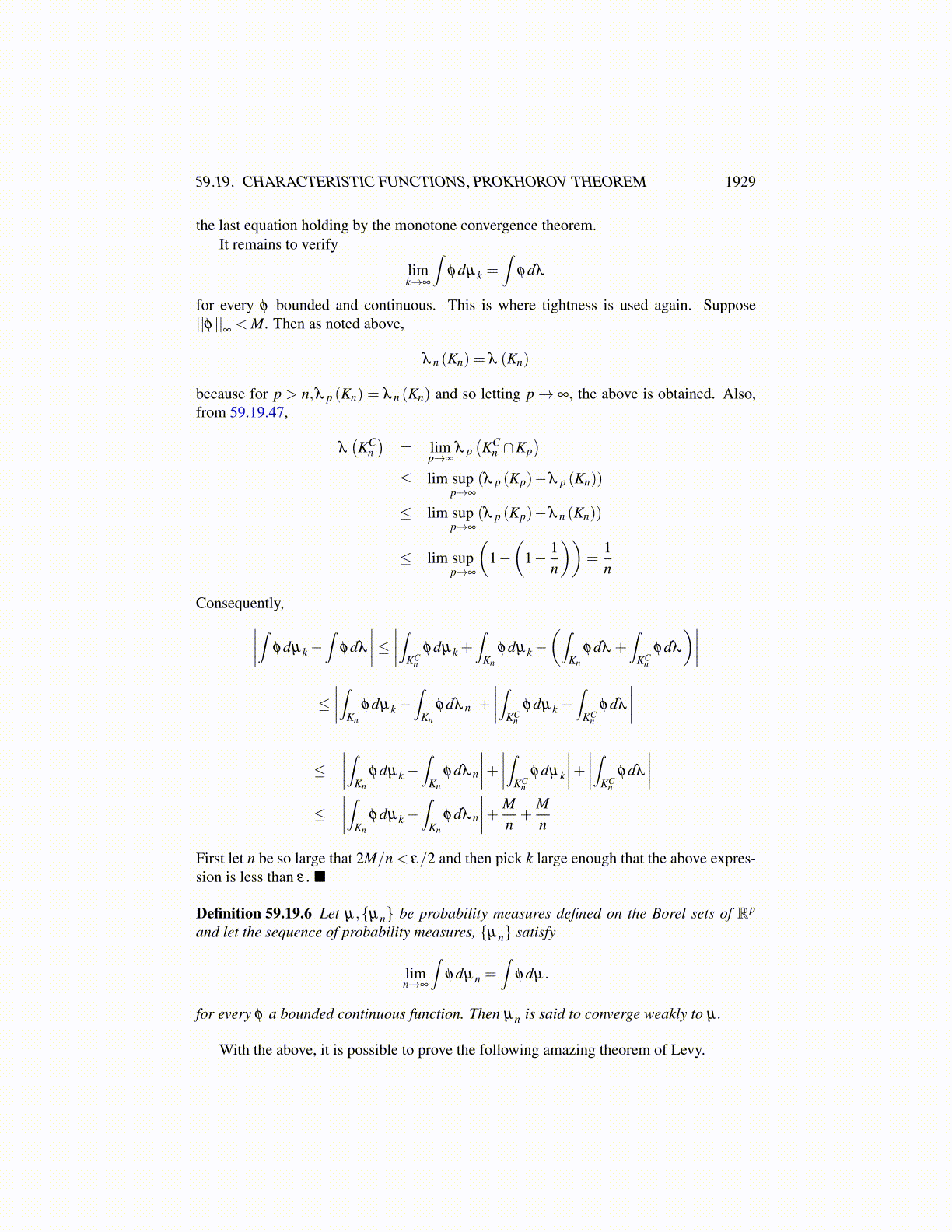
59.19. CHARACTERISTIC FUNCTIONS, PROKHOROV THEOREM 1929
mollifier whose support is in (−(1/k) ,(1/k))p. Then ψk converges uniformly to ψ and sothe desired conclusion follows for ψ after a routine estimate.
The next theorem is really important. It gives the existence of a measure based on anassumption that a set of measures is tight. The next theorem is Prokhorov’s theorem abouta tight set of measures. Recall that Λ is tight means that for every ε > 0 there exists Kcompact such that µ
(KC)< ε for all µ ∈ Λ.
Theorem 59.19.5 Let Λ = {µn}∞
n=1 be a sequence of probability measures defined on theBorel sets of Rp. If Λ is tight then there exists a probability measure, λ and a subsequenceof {µn}
∞
n=1 , still denoted by {µn}∞
n=1 such that whenever φ is a continuous bounded com-plex valued function defined on E,
limn→∞
∫φdµn =
∫φdλ .
Proof: By tightness, there exists an increasing sequence of compact sets, {Kn} suchthat
µ (Kn)> 1− 1n
for all µ ∈ Λ. Now letting µ ∈ Λ and φ ∈C (Kn) such that ||φ ||∞≤ 1, it follows∣∣∣∣∫Kn
φdµ
∣∣∣∣≤ µ (Kn)≤ 1
and so the restrictions of the measures of Λ to Kn are contained in the unit ball of C (Kn)′ .
Recall from the Riesz representation theorem, the dual space of C (Kn) is a space of com-plex Borel measures. Theorem 17.5.5 on Page 462 implies the unit ball of C (Kn)
′ is weak∗ sequentially compact. This follows from the observation that C (Kn) is separable whichfollows easily from the Weierstrass approximation theorem. Thus the unit ball in C (Kn)
′ isactually metrizable by Theorem 17.5.5 on Page 462. Therefore, there exists a subsequenceof Λ, {µ1k} such that their restrictions to K1 converge weak ∗ to a measure, λ 1 ∈C (K1)
′.That is, for every φ ∈C (K1) ,
limk→∞
∫K1
φdµ1k =∫
K1
φdλ 1
By the same reasoning, there exists a further subsequence {µ2k} such that the restrictionsof these measures to K2 converge weak ∗ to a measure λ 2 ∈ C (K2)
′ etc. Continuing thisway,
µ11,µ12,µ13, · · · → Weak∗ in C (K1)′
µ21,µ22,µ23, · · · → Weak∗ in C (K2)′
µ31,µ32,µ33, · · · → Weak∗ in C (K3)′
...
Here the jth sequence is a subsequence of the ( j−1)th. Let λ n denote the measure inC (Kn)
′ to which the sequence {µnk}∞
k=1 converges weak ∗. Let {µn} ≡ {µnn} , the diag-onal sequence. Thus this sequence is ultimately a subsequence of every one of the abovesequences and so µn converges weak ∗ in C (Km)
′ to λ m for each m.